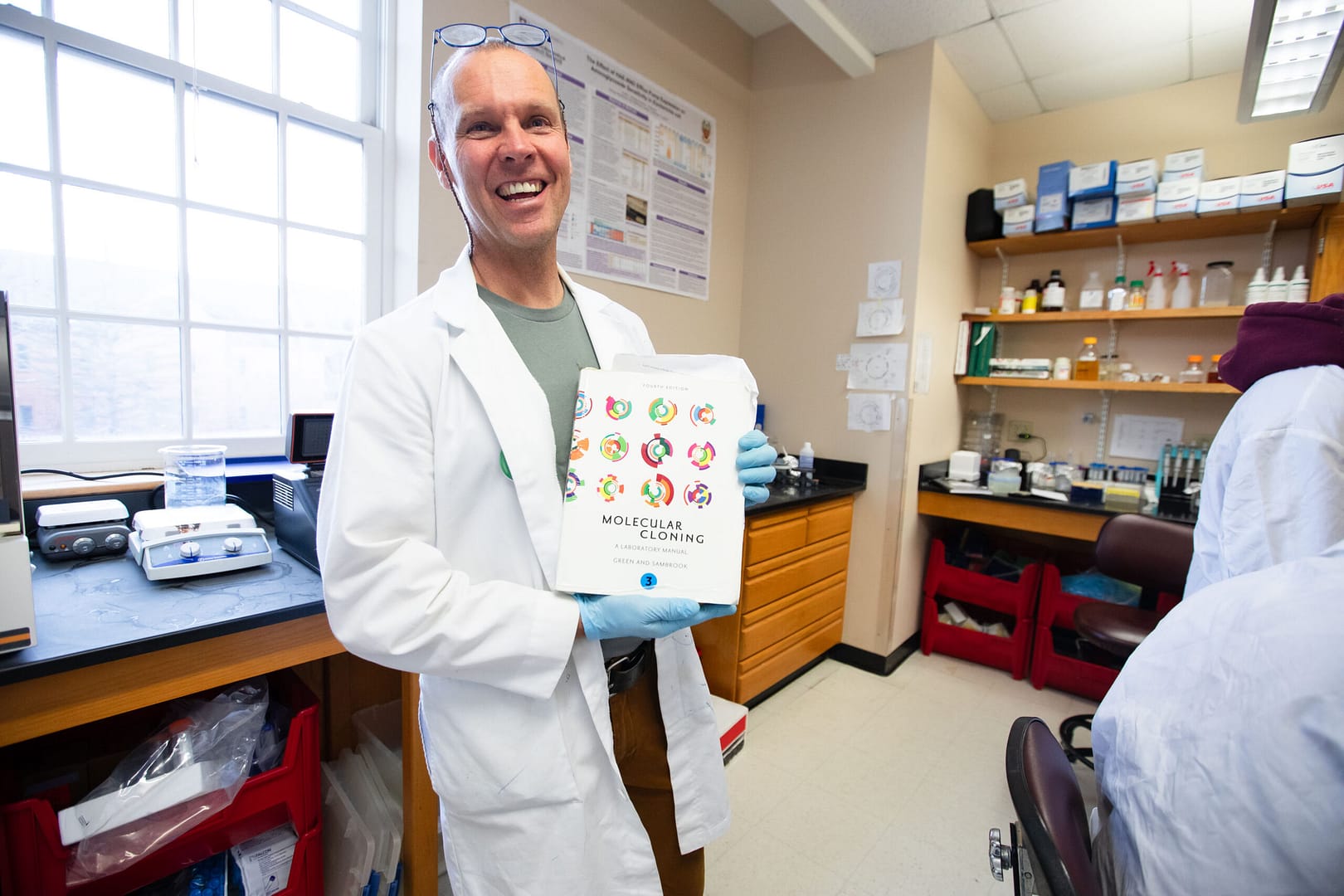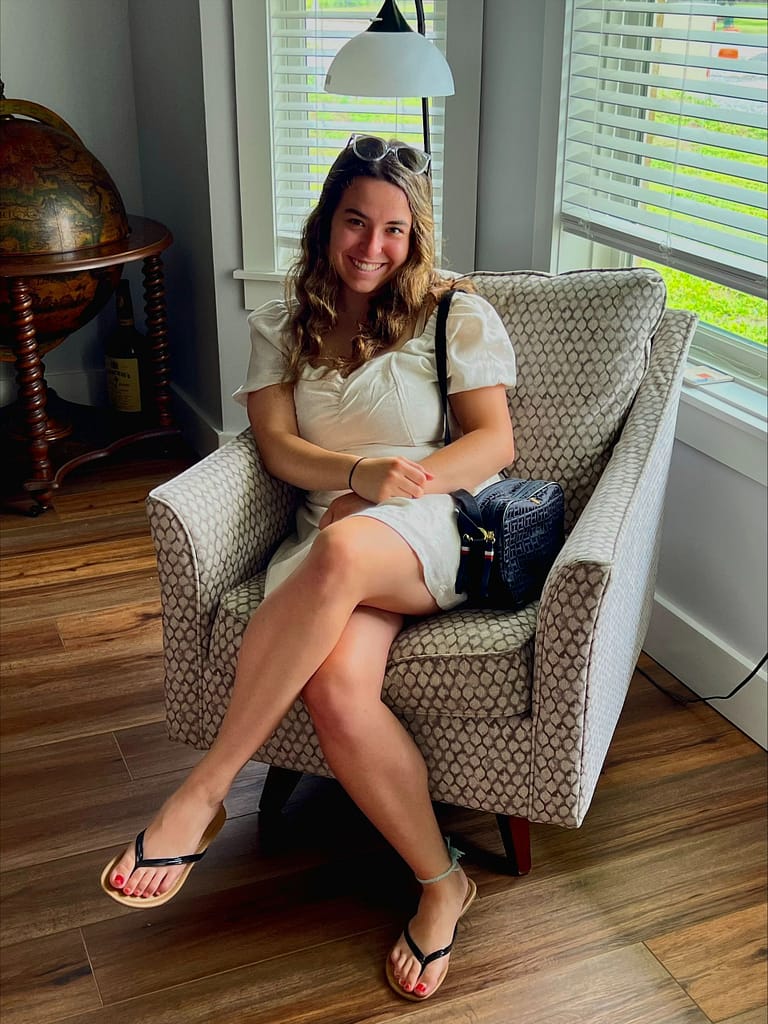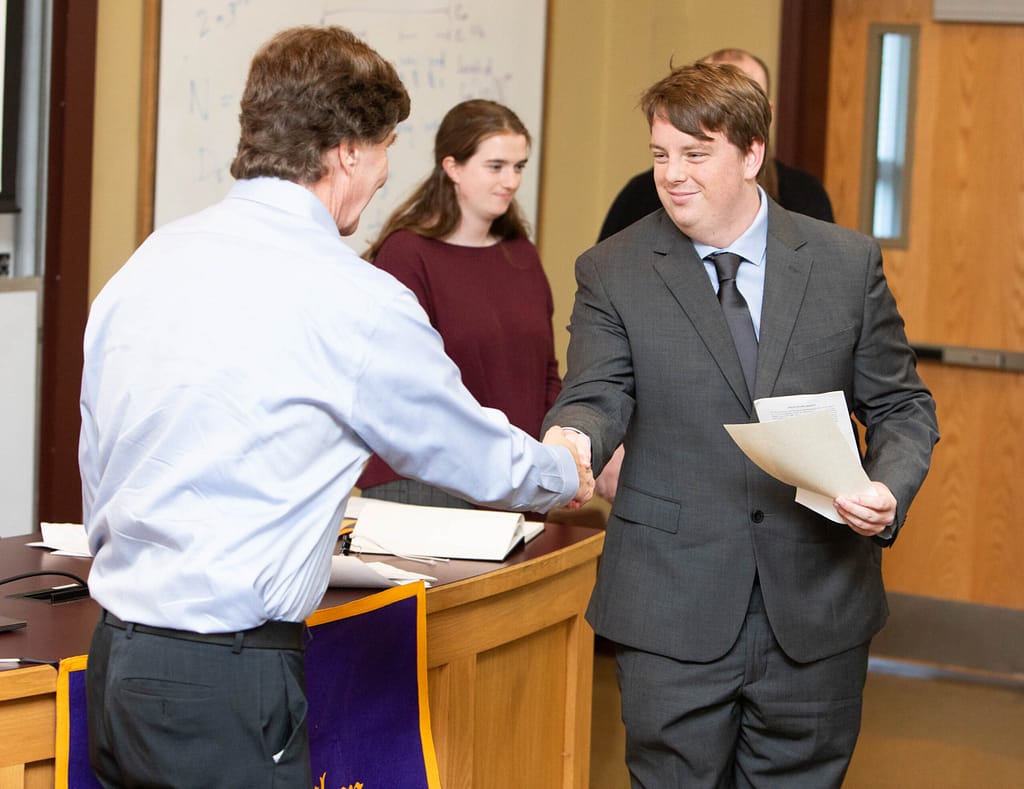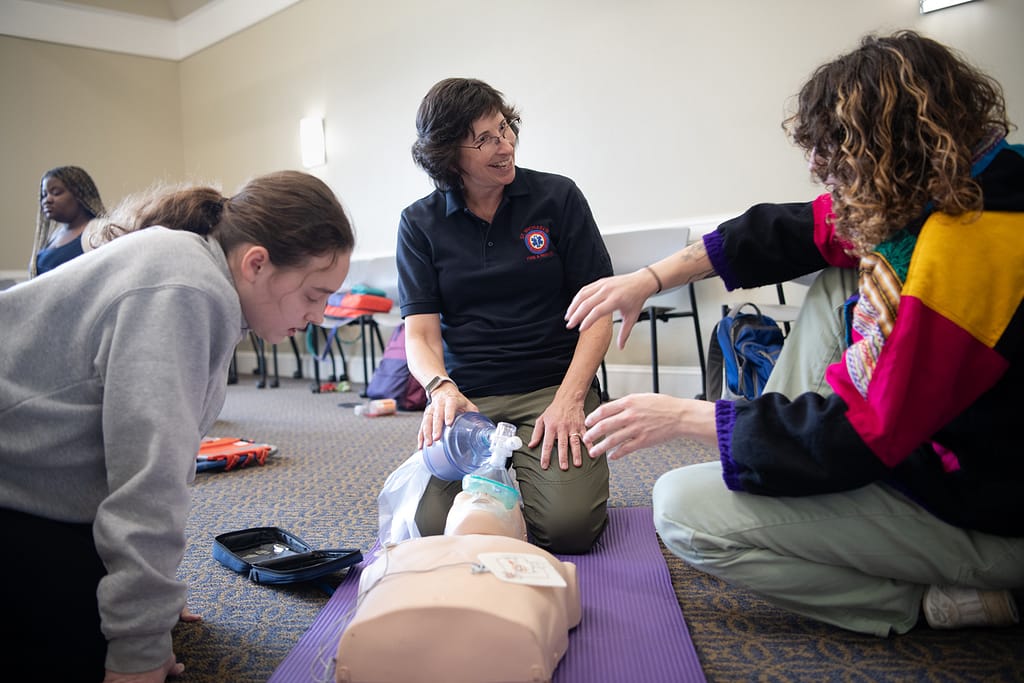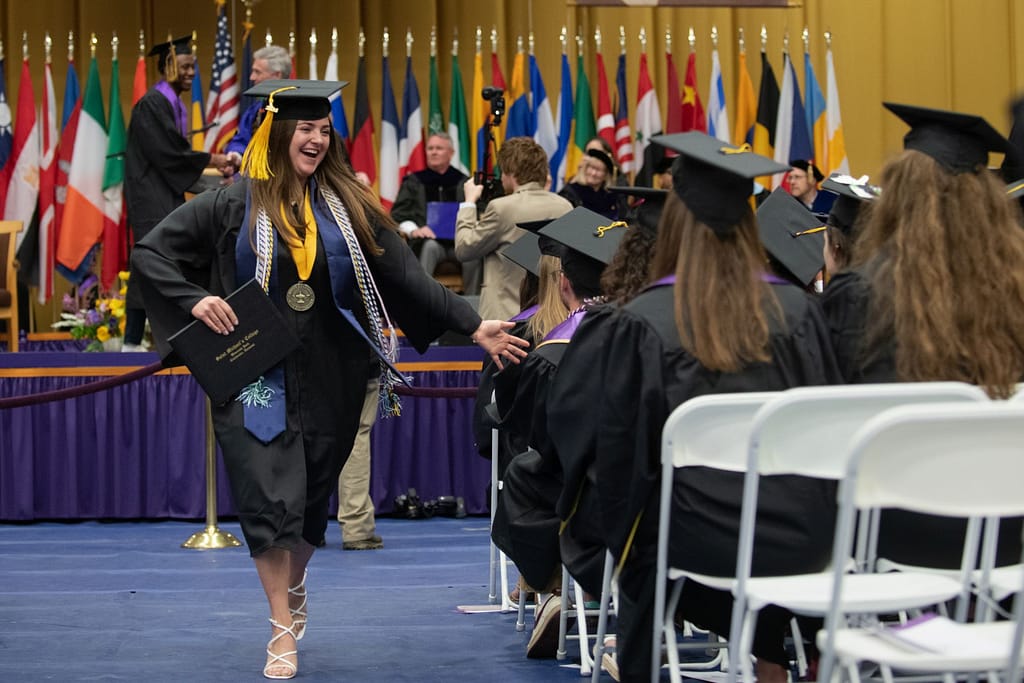Biology Professor earns international recognition for faculty-student research in ‘The Lub Lab’
Saint Michael’s College Biology Professor Mark Lubkowitz’s years of corn genetics research with dozens of students was recently recognized through a prestigious international award.
Lubkowitz was awarded the 2024 Maize Genetic Leadership Award at this year’s Maize Meeting, which was held in Raleigh, North Carolina, in March. The award recognizes maize cooperators who have inspired the lives and careers of other maize researchers through mentorship, leadership, outreach, and education.
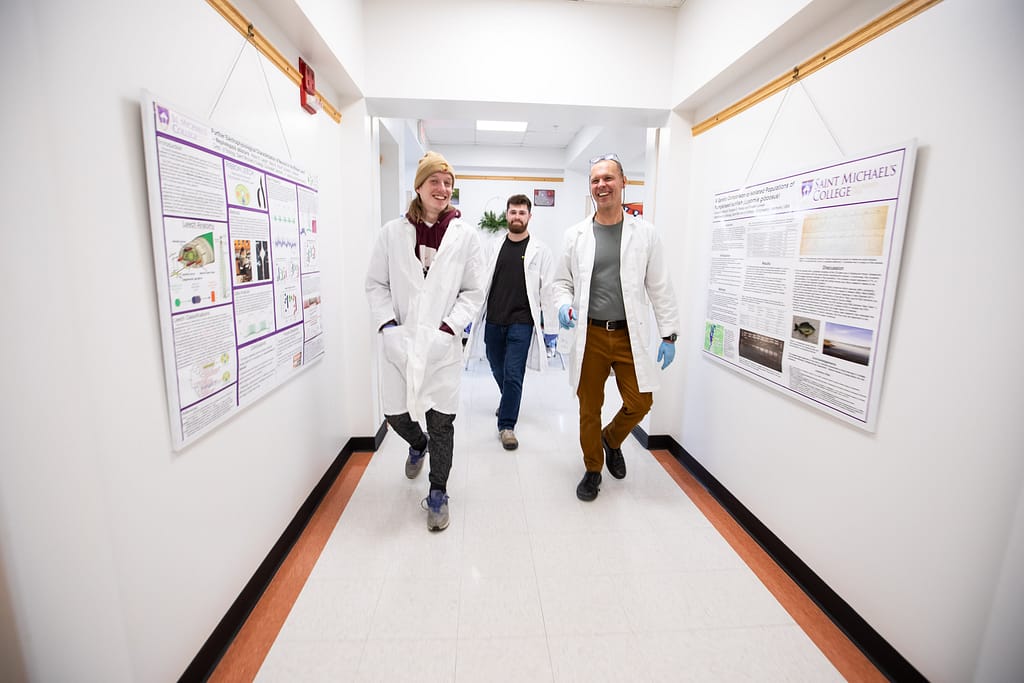
Brandon Boris ’24 and Pat Hogan ’24 walking to the lab with Mark Lubkowitz. (Photo by Cat Cutillo)
Six hundred scientists from all over the world participate in the conference each year, spending 16 hours a day talking corn. Most of the colleges and universities in attendance are “R1” top-tier research universities or land-grant institutions, where the professors’ primary focus is to train graduate and postdoctoral students to discover new research. Saint Michael’s is one of very few small liberal arts colleges in attendance each year.
“Almost everyone there is from a research university. In fact, I can only think of one other person from a small liberal arts college speaking at this meeting this century,” Lubkowitz said.

Brandon Boris ’24 and Pat Hogan ’24 (Photo by Cat Cutillo)
Lubkowitz started attending in 1998 and has taken students to 75% of the conferences, totaling 30 students over three decades.
“That was part of the reason I won that award was for bringing so many students over the years,” Lubkowitz said. “I was part of the original thinking group on how to increase, not just participation, but programming for undergraduates so we feed the STEM pipeline, as well as underrepresented individuals that have come to our conference.”
Lubkowitz said the conference is prime for networking, creating collaborations, and learning about grant opportunities. The National Science Foundation officers are there alongside seed companies. This year, Lubkowitz brought Brandon Boris ’24, Emilie Hoffmann ’24, and Kaitlyn Koutsoufis ’24. The trio presented a poster which illustrated the research they’d done about leaf angle over the summer.
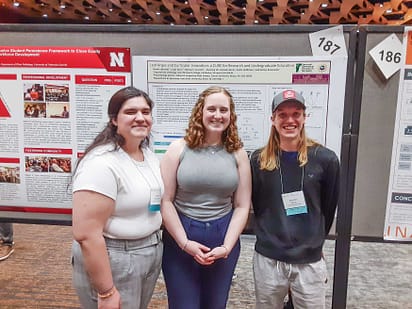
‘The Lub Club’ at this year’s Maize Meeting. Courtesy photo
“Their work was validated by global scientists,” Lubkowitz said. “My students were definitely in the limelight. Out of 600 people, there were probably 12 undergraduates there.”
Lubkowitz said the experience proves to be “transformative” each year for the students he brings, and they gain a deeper appreciation for their education at Saint Michael’s. He noted that even though “everyone in the room is a Ph.D. above” them, his students still understand what’s going on, which is empowering.
In 2022, Lubkowitz and Valerie Bang-Jensen of the Education Department were awarded a four-year grant to study leaf angle variation across the canopy of maize. It was funded through the National Science Foundation as part of the Plant Genome Research Projects. The grant runs from 2022 to 2026 and is a collaborative effort between scientists at Iowa State University, the University of Missouri, Cornell University and Saint Michael’s College. A portion of the$2.5 million grant – or $284,000 – went to Saint Michael’s.
Since receiving the grant, Saint Michael’s students have identified four switches that contribute to controlling leaf angle. The Saint Michael’s and Cornell University teams pass their information onto the teams at the University of Missouri and Iowa State University where Iowa State researchers grow the plants in the field. Saint Michael’s is on the discovery side of the genes and Iowa is on the discovery side of the plant and field conditions.
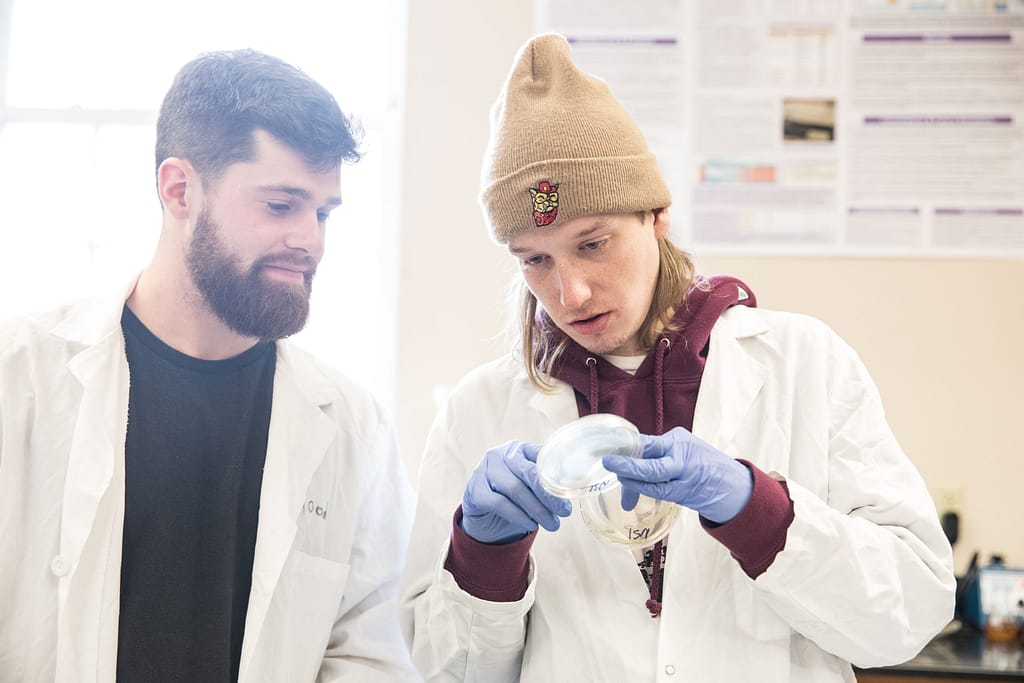
Pat Hogan ’24 and Brandon Boris ’24 (Photo by Cat Cutillo)
Lubkowitz used solar farm imagery to describe the research. The solar panels take light energy and make it into electrical energy. The panels are spread out to face the sun, and never stacked on top of each other because the ones at the bottom would be in the shade. Leaves, he explained, are like solar panels. They take light energy and turn it into chemical energy.
But when you look at an average cornfield, most of the leaves are stacked up on top of each other. That has led to a concept Lubkowitz called a “smart canopy.” Lubkowitz and his students are working on research to manipulate leaf angle so to maximize photosynthesis and minimize competition between plants. It’s based on latitude. The first step is to identify the genes that control leaf angle.
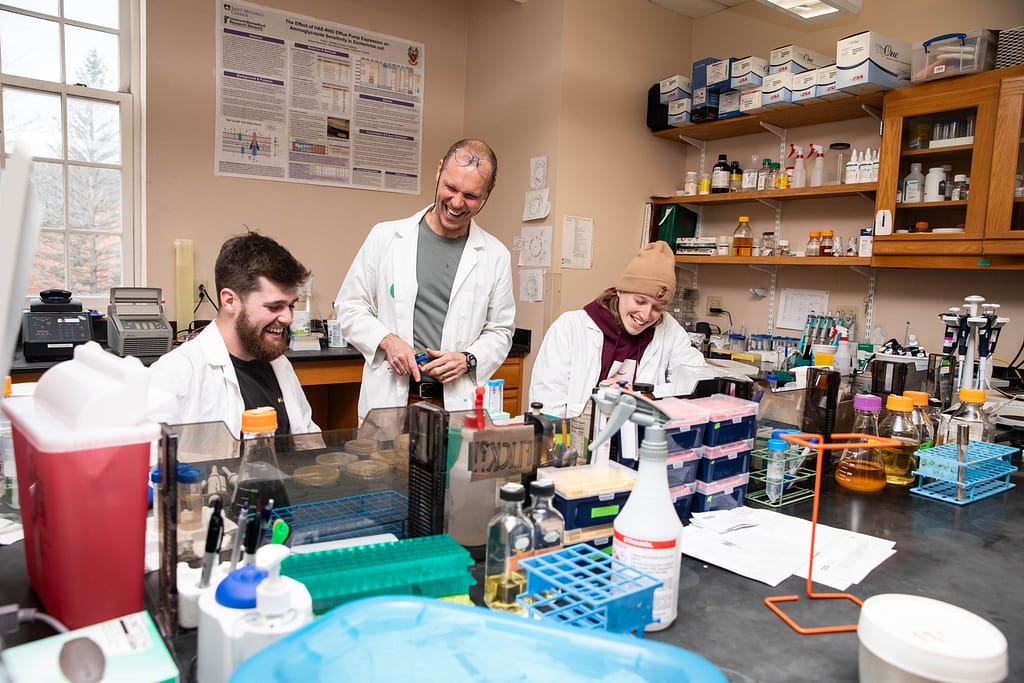
Mark Lubkowitz working with Pat Hogan ’24 and Brandon Boris ’24 in the lab. (Photo by Cat Cutillo)
“The leaves shade each other,” Lubkowitz explained. “If you change the leaf angle, you’ll get more photosynthesis. If you get more photosynthesis, you get more yield. You get more crop per unit acre. That lowers the cost of food. That lowers the environmental cost of growing food.”
Lubkowitz spoke at the conference this year about the research he’s been doing at Saint Michael’s with his students and about the collaborations with Cornell University, University of Missouri, and Iowa State University. During his talk, he highlighted how professors can conduct research even when they work at a college that doesn’t have students in post-doctoral or graduate studies. He used Saint Michael’s as an example, which has course-based undergraduate research experiences (CURES). Lubkowitz explained that at Saint Michael’s, he’s been able to integrate part of his research into his classroom. His research with the leaf angle grant is done both in his classroom and in the lab. Some students who take that class become his research students in his lab, where he works with students four days a week.
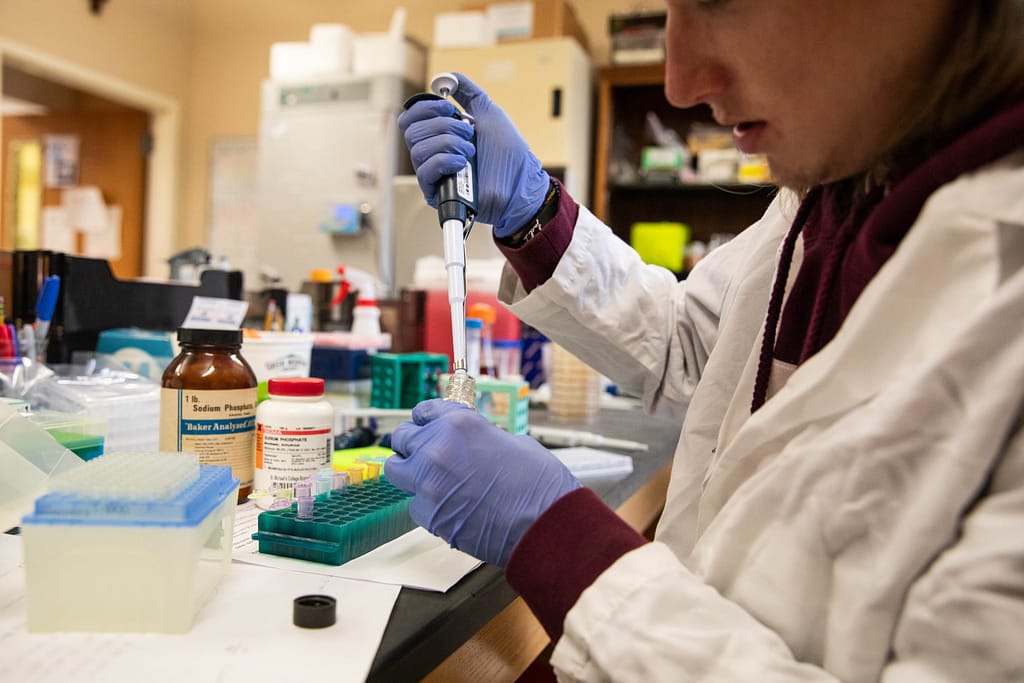
Brandon Boris ’24 working in the lab. (Photo by Cat Cutillo)
“If you learn science by doing science, we’ve created this mechanism by which two-thirds of our students in a given semester are doing a research-based curriculum,” Lubokwitz said. “They’re working on a faculty member’s research project and, hence, learning science by doing science.”
Brandon Boris ’24 attended this year’s Maize Meeting and had been working in “The Lub Lab,” which students affectionately call it, since last summer.
“I believe I played a critical role with my participation in the lab and truly am blessed to be able to be a part of something so amazing,” Boris said.
Many of the Saint Michael’s students Lubkowitz has taken to the conference have gone on to become scientists, doctors, and professors themselves. Saint Michael’s Director of the Institute for the Environment and Instructor, Kristyn Achilich, was a past student who attended the conference with Lubkowitz.
Maize, a $90 billion-per-year crop in the U.S., is the largest crop in the world currently. The researchers who work in corn study everything from deep evolutionary questions, domestication, disease, development, and yield.
Boris said being able to work closely with Lubkowitz on his faculty-led research project has been life-changing.
“I could go on about that man for hours. He makes it fun,” Boris said. “I don’t think I would have fallen in love with lab and corn if it wasn’t for him. He’s one of the most passionate people I’ve ever met.”
